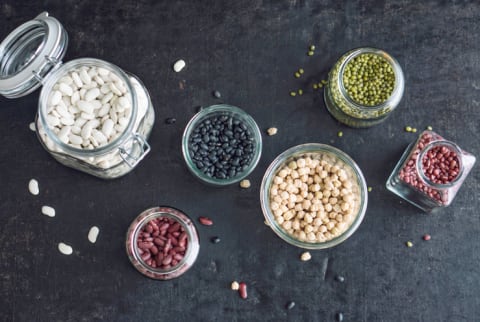Advertisement

Climate change may seem to many of us a challenge too daunting to tackle directly through our own actions. But there is one small change each of us can make to play our part: We can shift our diets so they're healthier and more environmentally sustainable.
The type of food we choose to eat makes up a large part of our personal carbon footprint. The meat and dairy that make up 22 percent of diets in the developed world emit large amounts of greenhouse gases — particularly dangerous methane and nitrous oxide.
But there's a more understated food group that has a relatively tiny carbon footprint and is highly nutritious and rich in protein and essential micronutrients: pulses.
Common beans (kidney, lima, pinto, etc.), chickpeas, fava beans, dried peas, and lentils are all pulses, and they have an extraordinary range of health and environmental benefits.
How are pulses good for the environment?
Pulses reduce the use of fossil fuels, since they don’t require nitrogen fertilizers. (A main component of nitrogen fertilizer is natural gas — a fossil fuel.) With a unique ability to “fix” nitrogen from the atmosphere, pulses are able to directly draw nitrogen from the air and convert it into nutrients vital for plant growth. Growing pulses also makes soils more fertile, reducing the need for fertilizer.
Pulses are the most water-efficient source of protein-rich foods. It only takes 43 gallons of water to grow a pound of pulses, compared to a whopping 1,857 gallons for beef! By the year 2030, demand for freshwater is expected to increase by more than 50 percent, and agriculture alone accounts for around 70 percent of freshwater use globally.
A crop's resilience against the rising temperatures and droughts associated with climate change will become very important for continued food and nutrition security. While pulses are already relatively climate-hardy, scientists are working to make them even more tolerant to these extreme weather conditions.
For example, the Kabuli chickpea, "Gokce," developed by the International Center for Agricultural Research in the Dry Areas (ICARDA) with Turkish national scientists, withstood severe drought in Turkey back in 2007 and grew when most other crops failed. Similarly, heat-tolerant fava bean and chickpea lines, being developed by ICARDA scientists in research partnership with Sudan, can withstand temperatures as high as 40 degrees Celsius (104 degrees Fahrenheit).
In the dryland areas where ICARDA’s research is focused, 12 million hectares of productive land is lost every year due to soil degradation — an area roughly the size of Greece or Bangladesh — so pulses are an important part of our strategy for increasing land productivity.
Why should you start eating more of them?
Meat consumption per capita has more than doubled in the developing world since 1963, while pulse consumption has dropped by almost 50 percent over the same period.
As consumers, by swapping out meat for pulses a few times a week, we can substantially reduce our carbon footprint and enjoy health benefits like a reduced risk of heart disease. With virtually no fat, pulses are high in essential micronutrients such as iron, zinc, potassium, magnesium, and selenium, dietary fiber, and "good" carbohydrates. To top it all off, they're a rich source of protein, with three times more than grains like wheat and rice.
It is clear that pulses are an incredible food that deserve more of our attention. For these many reasons, the United Nations has declared 2016 as the International Year of Pulses (IYP 2016).
Now is the time to incorporate more of these amazing crops into our own diets. Lucky for us, in addition to being powerful foods in the fight against climate change, pulses also happen to be delicious and versatile. From falafel and hummus to bean patties, lentil curries, salads, and soup, there are many ways to incorporate them into your daily diet.
These mbg-approved recipes can help you get started:
- Easy, Healthy Desk Lunch: Beet + Lentil Salad
- 15-Minute Dinner: Thai Vegetable + Chickpea Curry
Watch Next
Enjoy some of our favorite clips from classes
Enjoy some of our favorite clips from classes
What Is Meditation?
Mindfulness/Spirituality | Light Watkins
Box Breathing
Mindfulness/Spirituality | Gwen Dittmar
What Breathwork Can Address
Mindfulness/Spirituality | Gwen Dittmar
The 8 Limbs of Yoga - What is Asana?
Yoga | Caley Alyssa
Two Standing Postures to Open Up Tight Hips
Yoga | Caley Alyssa
How Plants Can Optimize Athletic Performance
Nutrition | Rich Roll
What to Eat Before a Workout
Nutrition | Rich Roll
How Ayurveda Helps Us Navigate Modern Life
Nutrition | Sahara Rose
Messages About Love & Relationships
Love & Relationships | Esther Perel
Love Languages
Love & Relationships | Esther Perel
What Is Meditation?
Box Breathing
What Breathwork Can Address
The 8 Limbs of Yoga - What is Asana?
Two Standing Postures to Open Up Tight Hips
How Plants Can Optimize Athletic Performance
What to Eat Before a Workout
How Ayurveda Helps Us Navigate Modern Life
Messages About Love & Relationships
Love Languages
Advertisement

These Peanut Butter Cup Protein Bites Make The Perfect On-The-Go Snack
Molly Knudsen, M.S., RDN











